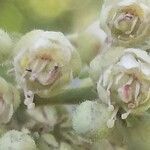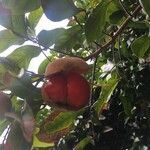A shrub or small tree. It grows 10-18 m high and spreads 3-5 m across. The bark is grey-brown and cracked. The young shoots are angular. The leaves are 10-30 cm long. The leaves are spreading and divided into leaflets along the stalk. There are 4-8 leaflets which are 7-15 cm long by 2-6 cm wide. They are broadly sword shaped. The flower panicles are 5-16 cm long and with many branches. The flowers are 0.4-0.6 cm across. The flowers are creamy-brown and have a scent. The fruit is a capsule 4-6 cm wide and with 3 lobes. The fruit are hard and yellowish-brown with a red aril around the seeds. This is edible. There are 3 seeds which are about 2 cm across.


